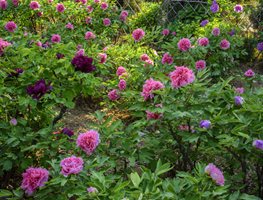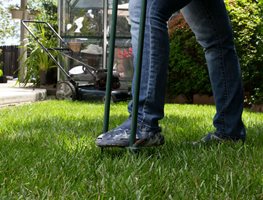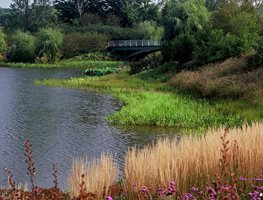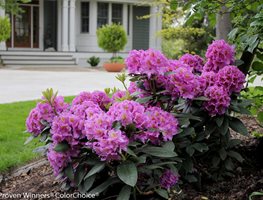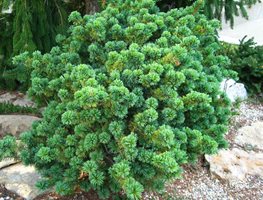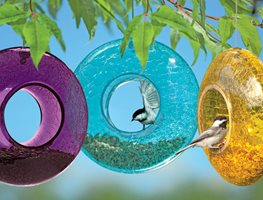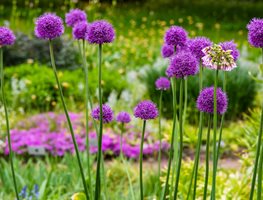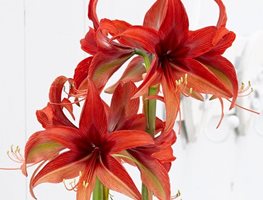10 Gardening Activities for September in the Midwest
Here are a few garden reminders, tips, inspiring ideas, and maintenance suggestions for your garden this month.
1. Plant and Divide Peonies
If you have peonies that need to be divided, now’s the time to divide and replant them around your garden. Get tips on transplanting and caring for peonies but keep in mind that you don’t have to divide your peonies for them to thrive. You can leave them in place indefinitely and they will still flower beautifully. The main reason to divide peonies by root division is to get more identical plants (peony seeds won’t grow identical to the parent plant). This video provides an overview on how to divide and plant peonies. If you’re looking to add to your peony collection, check out Spring Hill Nursery.
2. Aerate and Fertilize Your Lawn
Core aeration is the best method to aerate lawns. Using this method, you pull cylindrical plugs of grass and soil from the lawn, opening up tiny holes in the soil for new roots to form. To core aerate, you can hire a professional, rent equipment locally, or buy a manual aerator (just be ready for some exercise and make sure the lawn is watered well so the soil is soft). This procedure will help remove compaction issues, thatch, and poor drainage. After aeration, fertilize your lawn with a lawn fertilizer. Reseed areas of lawn that are bare or need rejuvenation. Wet weather and cooler temperatures will promote healthy roots and grass growth.
3. Harvest Berries and Cut Back Canes
This is likely the last month you’ll be harvesting berries such as everbearing raspberries that have a fall crop. Once you’ve harvested all berries, cut back canes of blackberries and raspberries to the ground. If your bushes have thorns, use long-sleeved rose pruning gloves. In cold climates it’s often best wait to plant new canes until early spring when the ground thaws because the freezing temperatures can damage new canes.
4. Visit the Chicago Botanic Garden
At 385 acres, the Chicago Botanic Garden has a lot to explore (don’t worry—tram tours are available to help you get familiar with the extensive garden!). They are currently open, with restrictions—check their website for hours and pre-registration requirements. There are all types of garden areas to see, including prairies, water gardens, native plant gardens, as well as fruit and vegetable gardens. Fall is especially nice because the weather has typically cooled and there’s still so much in bloom on Evening Island, in the Crescent Garden, and in the Prairie. Some of the plants CBG recommends for midwest gardens include asters, catmint, baptisia, clematis, ferns, geranium, grasses, hibiscus, hydrangea, phlox, and salvia.
If you'd prefer to take a virtual visit, you can explore some of the garden through the photos and descriptions online in our self-guided day trip for the Chicago area.
5. Add Spring-Flowering Rhododendrons and Azaleas to Your Garden
Peak bloom for rhododendrons and azaleas generally occurs in mid-spring; however, some bloom as early as March and others as late as July. There are thousands of varieties available, so it's easy to find one to suit nearly every garden. They prefer an area with filtered shade and good drainage, as well as a spot with protection from the wind. Water thoroughly before planting and position the crown of the root ball a few inches higher than the surrounding soil. Learn more about how to grow rhododendrons and azaleas.
Don't miss what to do in the garden each month, make sure you're getting our weekly newsletter.
6. Plant Conifers
Be sure to get new conifers in the ground by early October. Planting in September typically provides plants with warm days and cool nights which is the ideal condition for healthy root development. Wetter weather heading into fall also helps get plants off to the right start. Lastly, roots need time to develop before the soil freezes. Continue watering evergreens well until the ground freezes. If you’re looking for interesting varieties of conifers, try miniature or dwarf varieties which are perfect for tight spaces or smaller gardens. Several online nurseries that specialize in miniature or dwarf varieties or at least have a good selection available are Singing Tree Gardens or Kigi Nursery. Learn more in our Guide to Conifers.
7. Support Birds in Your Garden
Many of the birds in our cities and gardens need native trees such as oaks, cherries, and willows to survive. Fall is the best time to plant native trees. Doug Tallamy, University of Delaware professor and author of Bringing Nature Home and The Living Landscape, recommends planting natives instead of common garden trees that don’t support bird populations. In an article about plants that support wildlife, Tallamy states, “Instead of a Ginkgo, plant an oak. Gingkos support no caterpillar species—important bird food—while oaks support 557 species of caterpillars. Instead of Zelkova, which supports zero caterpillars, plant a black cherry, which supports 456 species. Instead of Pieris japonica, which also supports zero caterpillars, plant a native viburnum that supports 105 caterpillar species.” Your entire garden doesn’t need to be native, but planting key native trees can support many insects and birds. So why not plant a few native trees this fall? If space is tight, bird feeders can also help sustain non-migratory birds during winter. Check out these bird feeders at Gardener's Supply. Also see 10 Ways to Start Building a Garden for Wildlife.
8. Online Learning
Go back to “garden school” this fall with online gardening courses taught by talented experts in their respective fields. One of the instructors, Nicole Burke of Gardenary, offers an 8-session course that teaches you to create kitchen gardens (and even start your own business),with examples from her own kitchen garden in Chicago. Also explore courses about houseplants, shade plants, gardening basics, container gardening, and more.
9. Plan Ahead for Spring-Flowering Bulbs
You can plant spring-blooming bulbs in September and continue planting through early October. Each bulb variety has a different planting depth, so follow the directions on the package. A general guide is to plant bulbs three times deeper than the height of the bulb (so larger bulbs such as tulips and daffodils are planted deeper). If you still need bulbs, order soon from suppliers such as Breck's, Van Engelen, Brent and Becky's Bulbs, or Old House Gardens. Learn more about how to plant and store bulbs.
10. Order Amaryllis for Indoor Holiday Displays
September is the best time to order amaryllis for indoor displays. There are a number of online suppliers, such as Brecks or Eden Brothers. Many will sell out well before the holidays, so order early! Place your amaryllis on a well-lit countertop or window ledge. The bulbs will typically bloom 8 to 10 weeks after arrival. Check out these interesting varieties: ‘Bogota’ (pictured) or ‘Papilio’.
If you enjoyed this information, sign up for our weekly newsletter. Each week, you'll get Garden Design's best delivered right to your inbox including design tips, plant picks, great gardens, outdoor living products, and events to enjoy — along with monthly gardening checklists just for your area.
Do you know someone who would enjoy this Midwest Region gardening information? Why not share it with them?
When you purchase products through links on our site, we may receive an affiliate commission. Thank you for your support.
